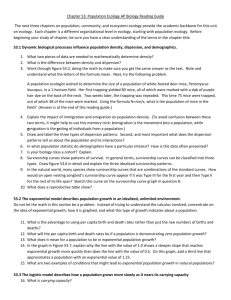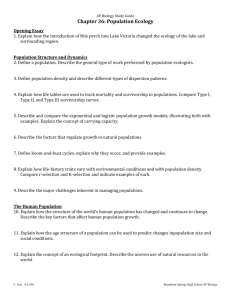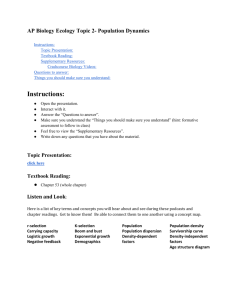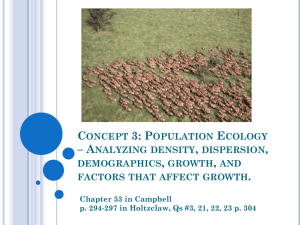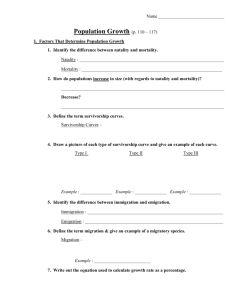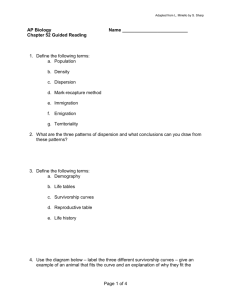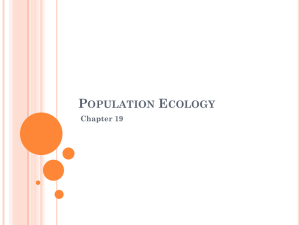REQUIRED READINGS ON ECOLOGY
advertisement
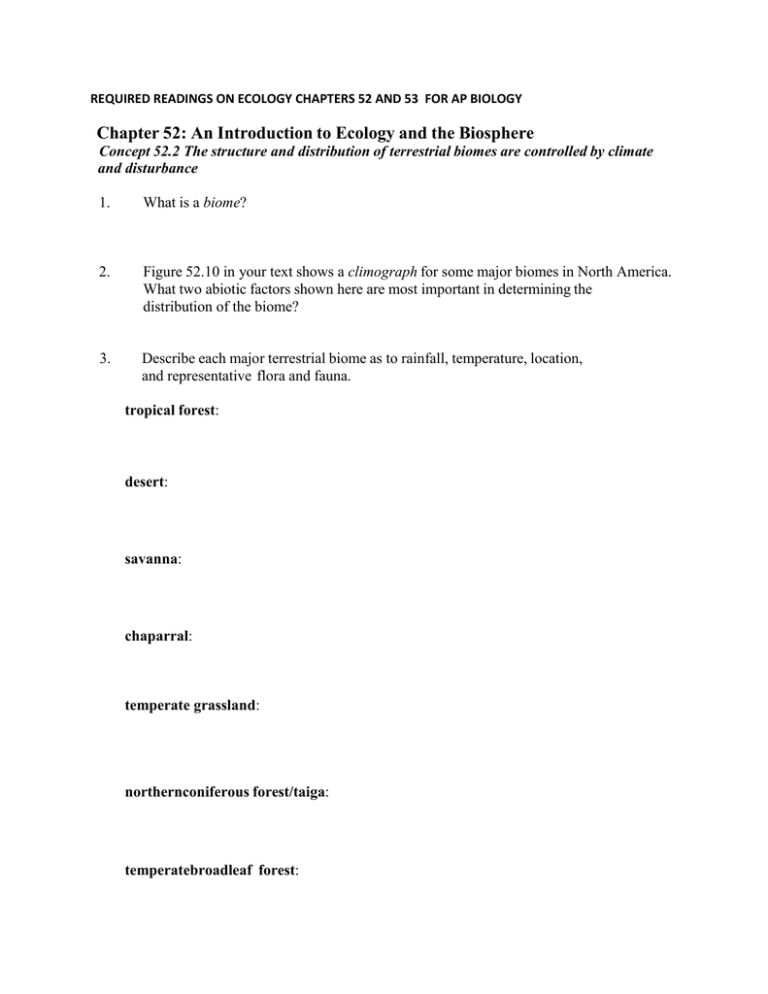
REQUIRED READINGS ON ECOLOGY CHAPTERS 52 AND 53 FOR AP BIOLOGY Chapter 52: An Introduction to Ecology and the Biosphere Concept 52.2 The structure and distribution of terrestrial biomes are controlled by climate and disturbance 1. What is a biome? 2. Figure 52.10 in your text shows a climograph for some major biomes in North America. What two abiotic factors shown here are most important in determining the distribution of the biome? 3. Describe each major terrestrial biome as to rainfall, temperature, location, and representative flora and fauna. tropical forest: desert: savanna: chaparral: temperate grassland: northernconiferous forest/taiga: temperatebroadleaf forest: tundra: Chapter 53: Population Ecology Name Period Chapter 53: Population Ecology Concept 53.1 Dynamic biological processes influence population density, dispersion, and demographics 1. What two pieces of data are needed to mathematically determine density? 2. What is the difference between density and dispersion? 3. Explain the impact of immigration and emigration on population density. (To avoid confusion between these two terms, it might help to use this memory trick: immigration is the movement into a population, while emigration is the exiting of individuals from a population.) 4. Draw three diagrams representing, clumped, uniform and random dispersion. What do the dispersion patterns tell us about the population and its interactions? 5. In what population statistics do demographers have a particular interest? How is this data often presented? 6. Is your biology class a cohort? Explain. 7. Survivorship curves show patterns of survival. In general terms, survivorship curves can be classified into three types. Draw a graph and label the three types of survivorship curves. For each curve, describe what it tells us about death rates during early, middle, and late life, and give an example of a species that has that type of survivorship curve. Concept 53.2 The exponential model describes population growth in an idealized, unlimited environment Do not let the math in this section be a problem. Instead of trying to understand the calculus involved, concentrate on the idea of exponential growth, how it is graphed, and what this type of growth indicates about a population. 8. What is the advantage to using per capita birth and death rates rather than just the raw numbers of births and deaths? 9. What will the per capita birth and death rates be if a population is demonstrating zero population growth? 10. What does it mean for a population to be in exponential population growth? 11. What are two examples of conditions that might lead to exponential population growth in natural populations? Concept 53.3 The logistic model describes how a population grows more slowly as it nears its carrying capacity 12. What is carrying capacity? 13. What are six examples of limiting resources that can influence carrying capacity? 14. In the logistic population growth model, the per capita rate of increase approaches zero as the _____________________________ is reached. 15. If the carrying capacity (or K) is 1,000 and N is 10, the term (K – N)/K is large. Explain why a large value for (K – N)/K predicts growth close to the maximum rate of increase for this population. 16. Explain why the logistic model predicts a sigmoid (S-shaped) growth curve when the population density is plotted over time. Hint: The critical part of this answer concerns why growth slows as N approaches K. 17. Explain the differences between K-selection and r-selection. Concept 53.4 Life history traits are products of natural selection 18. Explain the difference between semelparity (big-bang reproduction) and iteroparity (repeated reproduction) as life history strategies. 19. Explain how two critical factors influence whether a species will evolve toward semelparity or iteroparity. Concept 53.5 Many factors that regulate population growth are density dependent 20. Compare and contrast these two terms: density-independent regulation: density-dependent regulation: 21. Explain how negative feedback plays an essential role in the unifying theme of regulation of populations. Does negative feedback play a role in both densityindependent and density- dependent regulation? 22. Complete the following chart. Density-Dependent Population Regulation Negative Feedback Mechanism Competion for resources Predation Toxic wastes Intrinsic factors Explanation Example Territoriality Disease Concept 53.6 The human population is no longer growing exponentially but is still increasing rapidly 23. Summarize human population growth since 1650. 24. What is demographic transition? In demographic transition which falls first, birth or death rates? 25. You should be able to look at age-structure graphs and make predictions about the future growth of the population. Using Figure 53.24 in your text, describe the key features for the three age-structure graphs and predict how the population of each country will grow. Afganistan: United States: Italy: 26. Can the world’s population sustain an ecological footprint that is currently the average American footprint? Explain.
